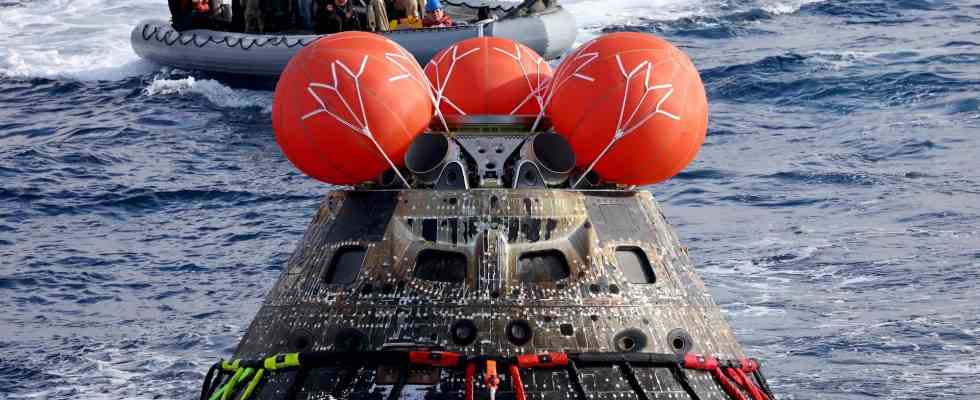Status: 03/12/2023 07:57 am
Three months ago, the “Orion” space capsule of NASA’s Artemis I moon mission landed in the Pacific. The test flight is considered an important step on mankind’s way back to the moon. Now NASA is already planning the manned follow-up mission.
After the mission is before the mission: the scientists from NASA, its partner agencies and industrial partners involved hardly had time to rest after the successful landing of Artemis I. Preparations for Artemis II are underway. This follow-up mission is intended to be the first time humans have launched towards the moon since the Apollo flights in the 1960s and 1970s.
Good cooperation
Thomas Zurbuchen, the former head of science at NASA, takes stock in an interview tagesschau.de: “Artemis I was an incredible success. It was a mission with a lot of risk. The rocket had never flown in this configuration before, plus the Orion capsule with the European service module. It all worked out.”
NASA broke new ground in several ways with the Artemis program: For the first time, the US has relied on another space agency, the European Space Agency ESA, to build a very important and critical part of a manned spacecraft.
In Europe – at Airbus in Bremen – a key element of the Orion spacecraft is being assembled: the European Service Module (ESM). It propels Orion and provides the astronauts with electricity, air and water. The ESM module is the heart chamber of the spaceship, so the pressure on those responsible in Europe was correspondingly high.
A model of the ESM service module being built in Bremen
Image: AFP
European balance sheet
The balance is very positive for them too. At a press conference in Bremen in February, Airbus said that the first evaluation of the test data showed that the Orion spacecraft used much less fuel and electrical energy than previously assumed. Marc Steckling, Head of Space Exploration at Airbus: “We used the first mission to put the module through its paces and found that it generated 15 percent more electricity because the solar cells are very good. And we have found that the propulsion system is very efficient. We used almost two tons of fuel less – which is 20 percent.”
This will enable future missions with a longer duration or with more cargo, such as module transports to set up the so-called “Lunar Gateway”, an intermediate station in lunar orbit. It’s supposed to be built in the 1920s and be a kind of “bus stop” in space on the way to the moon’s surface.
Artemis I stress test
Steckling continues: “We flew more maneuvers to simulate situations that do not normally occur. For example, we completely changed the setting angle of the solar cells in relation to the sun. Artemis I was of course the obvious choice, because there were no astronauts on board and you could put the system through its paces.”
“We flew longer, faster, with greater radiation exposure and many other things. The goal was to penalize the system to make sure that Artemis II really works because people are sitting on it,” adds former NASA chief of science Zurbuchen.
Airbus delivered the module for the Artemis II mission to Florida in October 2021. It is now being tested and integrated at the Kennedy Space Center.
astronauts to the moon
It is not yet clear which astronauts will be on board the Artemis II mission. But it can be assumed that no one from Europe will be among them, as is Artemis III. This mission is scheduled to start in 2025 at the earliest and not only orbit the moon, but also land on the lunar surface. NASA wants to bring the first woman and the first “person of color” to the moon.
ESA astronaut Alexander Gerst could become the first European to walk on the moon.
Image: dpa
ESA astronaut Alexander Gerst is considered a prime candidate for the first moon landing by a European. He was at Cape Canaveral when Artemis I launched in November. He was fascinated by the force with which the so-called SLS moon rocket, the most powerful rocket ever built, lifted off. At the Airbus press conference, he recounted his impressions: “You’re several kilometers away and the sound wave takes about 20 seconds to reach you. You see the rocket launch before you hear it. And the seismic wave is even faster than that Sound. You feel the ground shaking before the sound wave reaches you. It was an amazing thing to see this most powerful rocket that has ever flown take off.”
NASA checks
According to Zurbuchen, on the return flight of Artemis I, when the space capsule re-entered the Earth’s atmosphere, the heat shield on the underside of the capsule melted a little more than expected: “We have sensors on the inside that showed where the heat distribution and erosion is. Now we need to understand what exactly happened. That’s one of the things we’re working on at the moment.”
Protection for astronauts from radiation
Another is the evaluation of a radiation experiment inside the capsule. She’s still running. There were no astronauts on board Orion, but there were two measuring dummies. In the international research project entitled MARE (Matroshka AstroRad Radiation Experiment), under the leadership of the German Aerospace Center (DLR), thousands of detectors were installed in two “phantoms” to measure radiation in space and its effects on the human body measure.
A DLR team read some of the detectors in the USA in January after the mannequins had been removed from the space capsule. Now they are analyzed. The results are important to better protect astronauts on future manned missions. Such insights from Artemis I pave the way for subsequent missions back to the moon.

